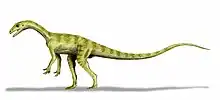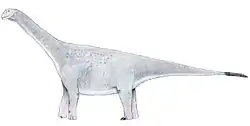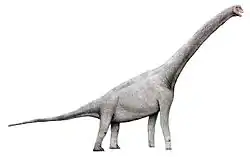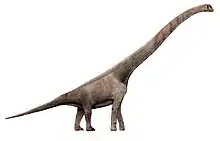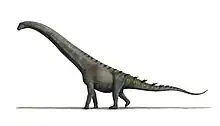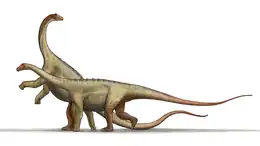Rhomaleopakhus
Rhomaleopakhus (meaning "strong forearm") is a genus of mamenchisaurid sauropod, dinosaur from the Late Jurassic Kalaza Formation of China. The type and only species is Rhomaleopakhus turpanensis.[1]
| Rhomaleopakhus Temporal range: Late Jurassic | |
|---|---|
| Scientific classification | |
| Domain: | Eukaryota |
| Kingdom: | Animalia |
| Phylum: | Chordata |
| Clade: | Dinosauria |
| Clade: | Saurischia |
| Clade: | †Sauropodomorpha |
| Clade: | †Sauropoda |
| Family: | †Mamenchisauridae |
| Genus: | †Rhomaleopakhus Upchurch et al., 2021 |
| Species: | †R. turpanensis |
| Binomial name | |
| †Rhomaleopakhus turpanensis Upchurch et al., 2021 | |
History
The holotype IVPP-V11121-1, was found by a Chinese-Japanese Chunichi Shinibun expedition near Qiketai in Shanshan, Xinjiang province in 1993, along with the holotype of Hudiesaurus,[2] and is a partially complete forelimb consisting of a humerus, ulna, radius, one carpal, and a partially complete manus that was originally assigned to the coeval mamenchisaurid Hudiesaurus.[2] Paul Upchurch in 2004 rejected the identity because of a lack of overlapping material.[3] However, in a 2021 reassessment of the latter genus, the forelimb was separated from its hypodigm and named the holotype of a new genus and species, Rhomaleopakhus turpanensis; the specific name refers to the Turpan Basin where the specimen was collected.[1]
Description
Upchurch et al. note that the robustness of the forelimb, after which the taxon was named, convergently evolved in what are called the "Core Mamenchisaurus-like taxa" (CMTs),[4] titanosaurs, and ceratopsids. They believe this correlates with a more flexed orientation of the forearm, an enhanced role of the forearm in feeding, and a more anterior shift in the center of mass. It is possible that CMTs and titanosaurs specialized in a feeding strategy that involved efficient locomotion between sparsely-located food sources.[1]
Classification
Upchurch et al. used Moore et al. (2020)'s[4] phylogenetic analysis to determine the relationships of Rhomaleopakhus. They found it to be a mamenchisaurid sister to Chuanjiesaurus, in a clade that also includes Analong. Their cladogram is shown below:[1]
| Mamenchisauridae |
| |||||||||||||||||||||||||||||||||||||||||||||||||||||||||||||||||||||||||||||||||
References
- Upchurch P, Mannion PD, Xu X, Barrett PM (2021). "Re-assessment of the Late Jurassic eusauropod dinosaur Hudiesaurus sinojapanorum Dong, 1997, from the Turpan Basin, China, and the evolution of hyper-robust antebrachia in sauropods". Journal of Vertebrate Paleontology. 41 (4): e1994414. doi:10.1080/02724634.2021.1994414. S2CID 245164168.
- Dong, Z. (1997). "A gigantic sauropod (Hudiesaurus sinojapanorum gen. et sp. nov.) from the Turpan Basin, China." Pp. 102-110 in Dong, Z. (ed.), Sino-Japanese Silk Road Dinosaur Expedition. China Ocean Press, Beijing.
- Upchurch, P.; Barrett, P.M.; Dodson, P.; 2004 "Sauropoda". In: Weishampel, D.B. and Dodson, P. and Osmolska, H., (eds.) The Dinosauria. p 259 - 322. University of California Press: Berkeley and Los Angeles
- Moore, A.J.; Upchurch, P.; Barrett, P.M.; Clark, J.M.; Xing, X. (2020). "Osteology of Klamelisaurus gobiensis (Dinosauria, Eusauropoda) and the evolutionary history of Middle–Late Jurassic Chinese sauropods". Journal of Systematic Palaeontology. 18 (16): 1299–1393. doi:10.1080/14772019.2020.1759706. S2CID 219749618.
